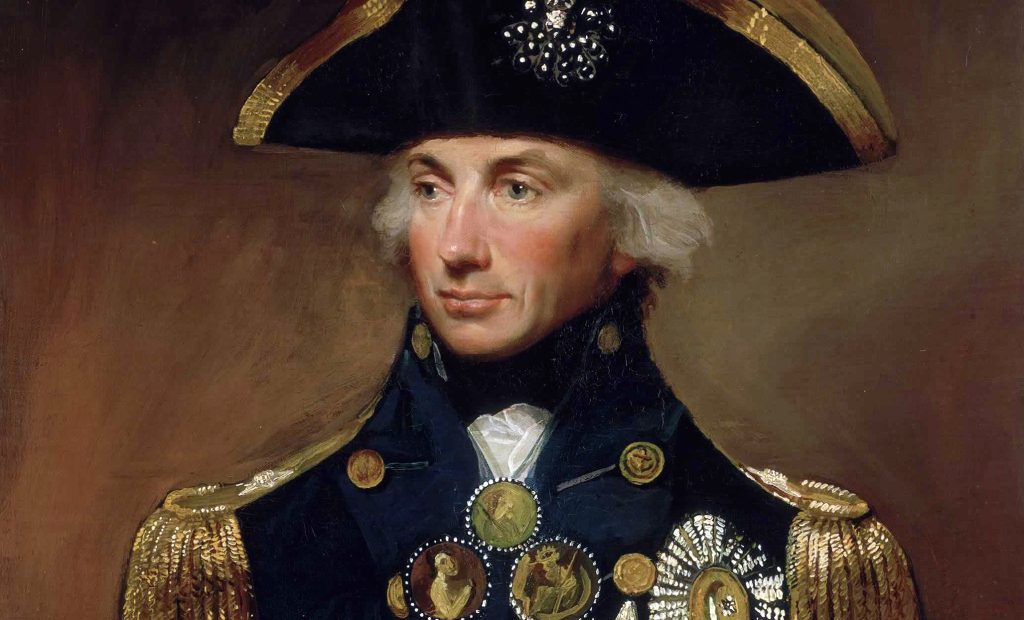By
Hazel Speed
21st October 1805
When we walk by the great statues in various major cities, quite often, unless the person represented is known to us, usually through history, we could be going past without even a glance as to looking for a name or detail of subject matter.
That cannot be said about one very famous landmark in the heart of London with a statue which towers above us all from Trafalgar Square – and I refer, of course to Admiral Lord Nelson’s Column.
Landseer designed the famous lions which flank the statue and many of us have climbed on the backs of these heraldic symbols of England to have our photographs taken, though which is now apparently causing damage. When writing this piece I learned that the lions are not identical, so I look forward to reviewing them next time I am in London. That said, when I can inspect the lions I may appear odd to others who might wonder what I am looking for, as a lion is a lion, is a lion!
When one reads the biography of Lord Nelson and then the great odds against his fleet of ships as he prepared strategy and tactics to fight (and subsequently win) the Battle of Trafalgar on 21st October 1805, at the cost of his own life, we cannot help but be moved by events on that day.
Prior to the Battle his message was relayed to all that ‘England Expects every man to do his duty’.
It is said that his colleague in command of another ship in Nelson’s Fleet (Collingwood) was seen walking on deck calmly eating an apple whilst in the midst of battle, so confident was he of success of the fight.
Nelson, though only 5′ 4″ in height, was in metaphorical terms, a giant of a man with the heart of a lion so Landseer’s usage of lions surrounding Nelson’s Column is an apt choice. Like many Service Personnel, Nelson paid the ultimate sacrifice and gave his all for his Country, along with many of his Company.
It has been pointed out, especially in recent years, within TV and radio documentaries that sailors or hands on deck, were representative of other countries as well as English.
Also, we must not overlook the depiction of sailors in a frieze section at the base of Nelson’s Column showing men on board ship as in the bottom left-hand corner of the art work is one black sailor, though his name is uncertain, the following listings may have included him therein.
On some occasions it is said a black sailor may have been called ‘Sambo’. Not said in any degrading way but they had considered it to have been his name or nick-name utilised by the sailor themselves. It explains the usage of such a reference over a hundred years later in England thereby proving what we may now consider to be non-PC or inappropriate, came about from an historic innocent fact. Proving, yet again, that only in the mind of man can some things become sullied as a taunt when in reality it commenced usage as a mark of respect.
Apparently, Admiral Lord Nelson suffered from sea-sickness but despite all the circumstances surrounding the great battle his winning non-conventional tactics won the day.
Admiral Lord Nelson’s Awards and Honours were many throughout his life. He also had the respect of his men.
I believe Lord Nelson had nine children and I often wonder about their lives and careers to this present day.
We have Nelson to thank for the expression ‘turning a blind eye’ to something which he did in response to a command at one time which required him to use a telescope and he put his blind eye to the viewing glass so he could report he saw nothing in order that he could take another course of action without telling a lie in the more normal usage of that term, though deception is another matter. We are led to believe Nelson thought his order was wrong strategically and this was his diplomatic way of dealing with the same. Not to be recommended by any Career Officers today however!
We all owe this great man our thanks for all he did for England and his fine example of leadership and bravery against what must have seemed overwhelming odds.
So please raise a glass or splice the mainbrace on 21st October 2016 in honour of Admiral Lord Nelson and his special endeavour on behalf of future generations from 1805.
His ship HMS Victory was indeed well named!
I had great joy in producing a 5′ painting of Admiral Lord Nelson myself and it was fun researching the various aspects portrayed therein. As when one writes, I had the uncanny sense this great National Hero was guiding my hand as I painted. Well wouldn’t we all do that if we knew we were being portrayed – even if viewing from Eternity!
I hope after I am gone, my painting will live on in some appropriate gallery.
Hazel Speed
Photo (c) Hazel Speed – used by kind permision to Tuck Magazine



Enjoyed this page from history. pck